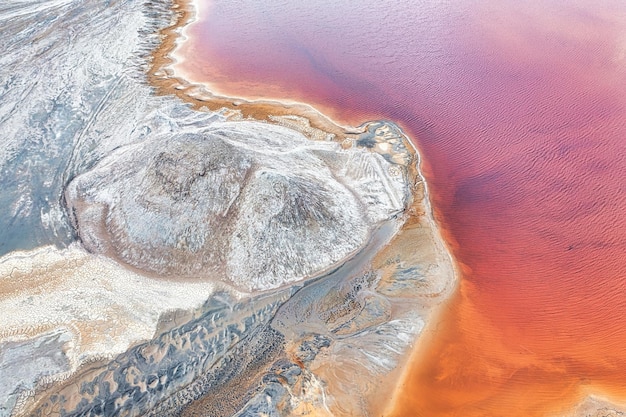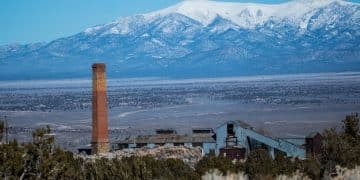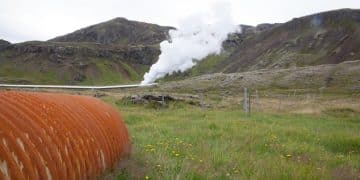Key Challenges to US Geothermal Energy Expansion by 2030

Scaling up geothermal energy production in the US by 2030 faces significant hurdles, including high upfront costs, technological limitations in accessing deep geothermal resources, regulatory complexities, and geographical constraints affecting resource availability and transmission infrastructure.
The United States holds immense potential for geothermal energy, a clean and sustainable resource that taps into the Earth’s internal heat. However, realizing this potential and significantly scaling up **what are the key challenges to scaling up geothermal energy production in the US by 2030** presents a complex set of challenges.
Understanding the Potential of Geothermal Energy
Geothermal energy offers a reliable and consistent source of power, unlike solar and wind which are intermittent. It also has a minimal land footprint when compared to other renewable energy sources. Scaling up geothermal energy production could contribute significantly to reducing the US reliance on fossil fuels and mitigating climate change. But what concrete obstacles are hindering this expansion?
Geothermal Energy: A Primer
Geothermal energy leverages the Earth’s internal heat to generate electricity. This heat is harnessed through various methods, including:
* **Hydrothermal resources:** Utilizing naturally occurring reservoirs of steam or hot water.
* **Enhanced Geothermal Systems (EGS):** Creating artificial reservoirs in hot, dry rocks by injecting water.
* **Geothermal Heat Pumps (GHPs):** Using the Earth’s stable temperature to heat and cool buildings.
Each method has its own set of challenges and opportunities for development. While hydrothermal resources are relatively easier to access, they are geographically limited. EGS, on the other hand, has the potential to unlock vast geothermal resources but requires significant technological advancements.
US Geothermal Resources: Untapped Potential
The US Geological Survey estimates that the US has the potential to generate tens of gigawatts of electricity from geothermal resources. However, only a small fraction of this potential has been realized. The western states, particularly California, Nevada, and Utah, have the most significant hydrothermal resources, but EGS could expand geothermal development to other parts of the country. Scaling production will require addressing specific hurdles.
In conclusion, the potential of geothermal energy in the US is substantial and can play a critical role in the transition towards a sustainable energy future. However, unlocking this potential requires overcoming significant technical, economic, and regulatory challenges.
High Upfront Costs and Investment Barriers
One of the most significant challenges to scaling up geothermal energy production is the high upfront capital costs associated with exploration, drilling, and power plant construction. These costs can be a major deterrent for investors.
Exploration Risks and Drilling Challenges
Geothermal exploration is inherently risky, with no guarantee of finding a commercially viable resource. Drilling deep wells to access geothermal resources can be expensive and technically challenging, especially in EGS projects. The cost of drilling can account for a significant portion of the overall project cost. Investors often shy away from these initial high-risk expenses.
Financing and Investment Incentives
Attracting private investment in geothermal projects requires a supportive policy framework that reduces risks and enhances returns. This includes:
* **Loan guarantees:** Providing government guarantees to reduce the risk of default on loans for geothermal projects.
* **Tax credits:** Offering tax credits to developers to offset the high upfront costs.
* **Feed-in tariffs:** Guaranteeing a fixed price for electricity generated from geothermal resources.
These incentives can level the playing field and make geothermal projects more attractive to investors. Without such support, geothermal development may struggle to compete with other energy sources.

Public-Private Partnerships
Public-private partnerships (PPPs) can be an effective way to leverage public and private resources to develop geothermal projects. PPPs can help to share the risks and costs of geothermal development and bring in the expertise and resources of both the public and private sectors. These collaborations can also foster innovation and accelerate the deployment of new technologies.
Concluding, high upfront costs and investment barriers remain a significant obstacle to scaling up geothermal energy production in the US. Addressing these challenges will require a combination of policy support, technological innovation, and creative financing mechanisms.
Technological Limitations and Research Needs
Advancements in geothermal technology are crucial for unlocking the full potential of this resource. Current technologies have limitations in accessing and utilizing deep geothermal resources.
Enhanced Geothermal Systems (EGS) Technology
EGS technology has the potential to significantly expand geothermal development by accessing hot, dry rocks that are not naturally permeable. However, EGS is still in its early stages of development and faces several technological challenges:
* **Fracturing:** Creating and maintaining fractures in the rock to allow water to circulate.
* **Water loss:** Preventing water from leaking out of the reservoir.
* **Induced seismicity:** Minimizing the risk of earthquakes caused by injection.
Addressing these challenges requires further research and development in areas such as advanced drilling techniques, reservoir modeling, and seismicity monitoring.
Advancements in Drilling Technologies
Traditional drilling technologies are often inadequate for accessing deep geothermal resources. Advancements in drilling technologies, such as:
* **Advanced drilling bits:** Capable of penetrating hard rocks at high temperatures.
* **Directional drilling:** Allowing wells to be drilled at angles to access a larger area.
* **Closed-loop systems:** Reducing water usage and minimizing environmental impacts.
These technologies can significantly improve the efficiency and cost-effectiveness of geothermal drilling. Investment in these technologies is crucial to expand geothermal access.
Finally, technological limitations and research needs are a significant hurdle to scaling up geothermal energy production. Overcoming these necessitates increased investments in research and development, particularly in EGS technology and advanced drilling techniques.
Regulatory and Permitting Challenges
The regulatory and permitting processes for geothermal projects can be complex and time-consuming, adding to the costs and delays associated with development.
Federal and State Regulations
Geothermal projects are subject to a variety of federal and state regulations, including:
* **Environmental regulations:** Protecting air and water quality and minimizing impacts on wildlife.
* **Land use regulations:** Governing the use of public and private lands for geothermal development.
* **Water rights regulations:** Determining the allocation of water resources for geothermal projects.
Navigating these regulations can be challenging, especially for developers who are unfamiliar with the regulatory landscape. Improving coordination between federal and state agencies and streamlining the permitting process can reduce delays and costs.
Permitting Processes and Timelines
The permitting process for geothermal projects can take several years, depending on the location and complexity of the project. This can be a major deterrent for developers, as it increases uncertainty and delays the return on investment.
* **Expediting permitting:** Streamlining the permitting process and setting clear deadlines for agency reviews.
* **Stakeholder engagement:** Involving local communities and other stakeholders in the permitting process.
* **Standardized permitting:** Developing standardized permitting procedures across different states.
These measures can help to reduce the time and cost associated with permitting and facilitate geothermal development.

Community Engagement and Acceptance
Gaining community acceptance is crucial for the success of geothermal projects. Community concerns about environmental impacts, noise, and visual aesthetics can delay or even halt projects. Engaging with local communities early in the development process and addressing their concerns can help to build support for geothermal projects.
Finally, regulatory and permitting challenges can significantly hamper geothermal energy expansion. Resolving these constraints will require enhanced coordination among federal and state agencies, streamlining permitting, and proactive engagement with local communities.
Geographical Constraints and Resource Accessibility
Geothermal resources are not evenly distributed across the US, with most high-temperature resources located in the western states. This geographical constraint limits the potential for geothermal development in other parts of the country.
Transmission Infrastructure Limitations
Even in regions with abundant geothermal resources, the lack of adequate transmission infrastructure can limit the ability to transport electricity to load centers. Upgrading and expanding transmission infrastructure is essential for delivering geothermal power to consumers. This involves significant investments and permits, which can take years to complete.
Enhanced Geothermal Systems (EGS) Potential Across the US
While high-temperature hydrothermal resources are concentrated in the West, EGS technology has the potential to unlock geothermal resources in other parts of the US. EGS could expand geothermal development to areas that are currently not considered to be geothermally viable. This is particularly important for states in the East and Midwest, which have limited access to other renewable energy resources.
Remote Locations and Project Viability
Many geothermal resources are located in remote areas, far from existing infrastructure. This can increase the cost of development and make projects less viable. Overcoming this requires investing in transport systems to reach remote locations and developing smaller, distributed geothermal power plants that can serve local communities.
In conclusion, geographical constraints and resource accessibility pose considerable difficulties for geothermal energy development. While hydrothermal resources are geographically limited, EGS technologies can potentially unlock geothermal resources in previously inaccessible locations across the US.
Public Awareness and Education
Lack of public awareness and understanding of geothermal energy can hinder its deployment. Many people are unfamiliar with geothermal energy and its benefits. This lack of awareness can lead to misconceptions and opposition to geothermal projects.
Educating the Public on Geothermal Benefits
Raising public awareness of the environmental, economic, and social benefits of geothermal energy is essential to build support for its development. This can be achieved through:
* **Educational campaigns:** Providing information about geothermal energy through websites, social media, and other channels.
* **Community outreach:** Engaging with local communities to educate them about geothermal projects and address their concerns.
* **Demonstration projects:** Showcasing successful geothermal projects to demonstrate the technology’s potential.
Increased awareness can lead to greater acceptance and support for geothermal energy and create a more favorable environment for its deployment.
Addressing Misconceptions About Geothermal
Misconceptions about geothermal energy, such as concerns about induced seismicity and environmental impacts, can create barriers to its development. Addressing these misconceptions requires transparent communication and providing accurate information.
* **Scientific data:** Sharing scientific data and research findings to dispel myths and address concerns.
* **Expert opinions:** Providing access to experts who can answer questions and provide accurate information.
* **Open dialogue:** Engaging in open and honest dialogue with communities to address their concerns.
Therefore, public awareness and education play a crucial role in scaling up geothermal energy production. Raising awareness about geothermal energy’s benefits, counteracting misunderstandings, and promoting acceptance are critical for its wider implementation.
| Key Aspect | Brief Description |
|---|---|
| 💰 High Initial Costs | Exploration, drilling, and plant construction require significant investment. |
| ⚙️ Technological Hurdles | EGS technology requires advancements in fracturing and water management. |
| 📜 Regulatory Issues | Permitting processes are complex and time-consuming, delaying projects. |
| 🌎 Geographical Limits | Resources are concentrated in the West, needing better transmission. |
Frequently Asked Questions
▼
Geothermal energy is a renewable and sustainable energy source that provides a consistent power supply. It has a small land footprint compared to other renewables and helps reduce reliance on fossil fuels.
▼
Enhanced Geothermal Systems (EGS) involve creating artificial reservoirs in hot, dry rocks by injecting water. This allows geothermal energy to be harnessed in areas without natural water reservoirs.
▼
High exploration, drilling, and construction costs necessitate substantial initial investments. This financial burden can deter investors, impeding the widespread adoption of geothermal energy projects.
▼
Complex federal and state regulations, along with lengthy permitting processes, add time and costs to geothermal projects. These delays and expenses hinder geothermal adoption throughout the United States.
▼
Increased public awareness and understanding of geothermal energy’s benefits can foster greater acceptance and support for its development. Education helps dispel misconceptions and encourages community involvement.
Conclusion
Scaling up geothermal energy production in the US by 2030 requires a concerted effort to address high upfront costs, technological limitations, regulatory complexities, geographical constraints, and public awareness gaps. Overcoming these challenges will unlock the vast potential of geothermal energy and contribute significantly to a sustainable energy future for the nation.





